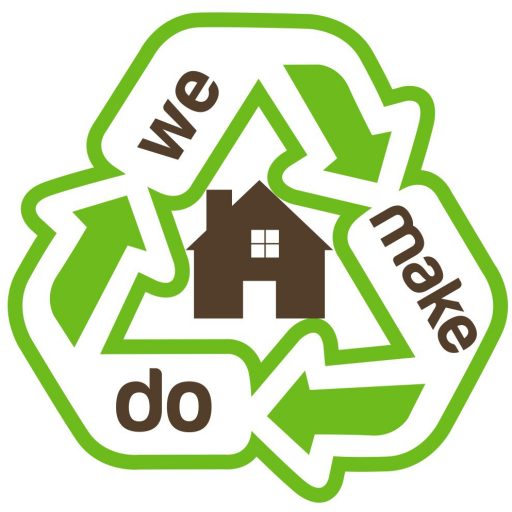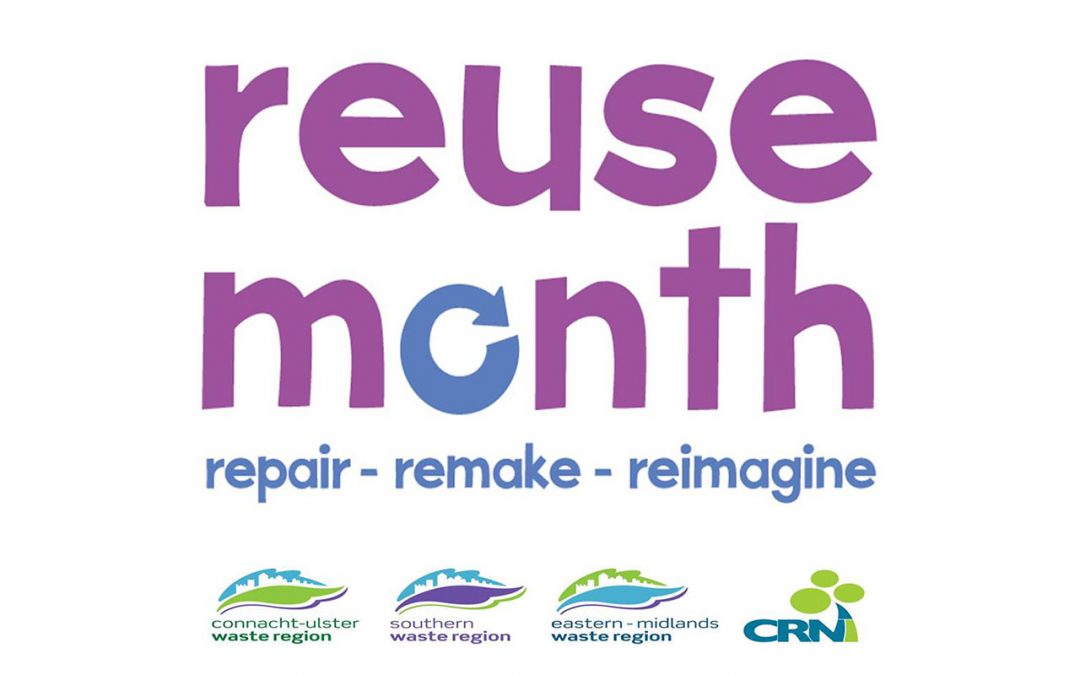
by wemakedo | Oct 14, 2016 | reuse |
Clearing stuff from your life to make space for better things..
There is no doubt that stuff brings hassle. Of course stuff bring utility value and pleasure is many ways but if we are honest about the stuff we have chosen to surround ourselves with, does it all continue to bring pleasure and usefulness after that initial perceived need has passed or does some of it become a burden when the novelty has worn off or some small part has broken and repairing it just isn’t worth the effort?
Our WeMakeDo family has recently chosen to get more ruthless about the stuff we choose to keep in the house and even more ruthless about what new things we bring into the house. When we did some reading from the many resources that discuss decluttering, it is suggested that there are additional beneficial effects when you start to reduce the amount of things you surround yourself with and need to be concerned about. You might think of it as a Feng-Shui kinda thing…or maybe that having more physical space in your home can translate into more mental space in your life.
We have generally scrutinized purchases well in advance of making them – i.e. discussed between us whether we really want one of these (whatever it happens to be) before making the purchase. Then we try to be conscientious about either repairing damaged items to get more life from them or moving them on when we think no more value can be had. But when one starts to think about the quantity of household waste we generate (as we did recently in trying to go plastic free and zero waste) it’s clear that avoiding plastic wrapping on your groceries isn’t so impact-ful if you are buying and dumping much larger household items on a regular basis.
Stuff adds complexity to your life and takes from the time you have that is not already absorbed by the non-negotiable demands we all have. Spending time with our kids is one area where we all should probably do more but it tends to compete with the flexible time we have that can be spent dealing with the extra stuff in our lives – fretting over the stuff, maintaining / repairing the stuff, cleaning the stuff, paying for the stuff, etc. As a family that tries to maintain some self-sufficiency in terms of repairs and maintenance we have found that this certainly can be a big time sink and is at odds with many of the things we know are better use of our time (time with kids, hobbies, personal development, etc.). Consumerism has been teaching us that we can buy time savings from things..but these things bring additional costs in terms of your time and attention into your life beyond the first cash outlay. This is why we believe letting less of the non critical stuff into your life in the first place and then making sure it’s of high quality and likely to demand less time during its useful life is an important the first step to regaining control over your time.
To slow the accumulation of things in our home, we needed to change mindset and begin evaluating our purchases differently. What you purchase costs more than the price you pay on the day. Each additional thing you purchase will also use your time, energy, and effort once it’s in your home. You may be buying it for its apparent time saving benefits as portrayed by the company that wants your money, but sometimes there are less obvious costs of ownership that should alos be considered. Before making a purchase, you could begin asking yourself these questions:
- Is this item really needed – beyond the immediate need I’ve already convinced myself of and keeping in mind it will eventually need to be disposed of?
- Do I have a place to store it knowing it may be around for a long time? and do I want to give up that space to this thing?
- How much extra work and pleasure will this thing add to my life?
Others have put this more succinctly: we need to constantly think about our “Joy-Stuff balance”. More stuff tending to mean less joy beyond a certain threshold of utility value. There are different levels on this scale. For example buying and running a second car has a high cash cost, and high hassle cost but then if you decide it needs to be done then presumably the utility value derived is expected to be high (and presumably higher than the costs) – but is it really the case?.On the other end of the scale, did we really need to have a regular set of plates that we use every day and also a “good” set of plates that have literally been used a couple of times since we got married?.Our new answer to this is no and so they are gone to a better home to be reused by someone who can appreciate them. We have spent that last couple of weeks creating piles around the house of stuff that none of us has used in 6 months or that we don’t have any attachment too. It’s an easy question to ask yourself once you’re in the right frame of mind: “does this thing bring me joy?” or “would I care if it was gone?”
So far we’ve not had any difficulty in decisively answering this question and moving stuff we no longer want, on to friends and charity shops mostly and via Donedeal in some cases. An opportunity for some reuse we hope. We are now firmly on this path of decluttering our lives and we have found that as you remove more stuff there is a great associated feeling of well-being that increases as you live with fewer things. We’re hooked and enjoying the process immensely! Most importantly it makes you scrutinize what you buy and why. This is not driven by money savings but instead driven by not wanted to refill your life with more stuff unless “necessary” and “necessary” now has a new meaning!
October has been designated as “National Reuse Month” by the Community Reuse Network of Ireland. They are urging us to pledge to reuse more during the month. We are hoping to give away as much of our unused stuff as we can to others who are willing to reuse it for us – as classic win-win situation wouldn’t you agree?
For more ideas about reuse opportunities – check out our “Make” page where we show some items we’ve repurposed in different ways
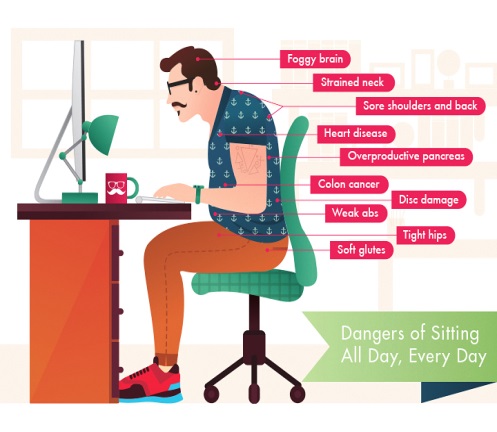
by wemakedo | Sep 23, 2016 | health |
In this post we stray a little from our recent interests in self sufficiency and minimizing waste to discuss a health concern we learned about that we felt important enough to share.
There is a lot of recent writing about the dangers associated with a sedentary lifestyle. Those of us who spend our day sitting at a desk or in front of a computer are told that we should exercise more. But what if the problem is not just the lack of exercise, but the actual sitting itself? It does seem somewhat intuitive that sitting down and hunching over a PC for hours during the day is not really what our bodies were meant to be doing. The convention at most office workplaces has meant that we now sit for up to 8 hours each day with few breaks, then drive home (seated) and possibly sit for more hours in the evening for relaxation. I myself have spent many hours doing so for nearly 20 years now. Thankfully I work for a company that is very aware of the ergonomic risks associated with the standard desk work setup and much effort is spent on educating people about the risks of repetitive strain injuries. This may help prevent aches and pains, but what about the more serious risks?
I came across this article and discovered it was one of many summarizing the newly identified dangers associated with sitting for extended periods.
To highlight some findings in the article:
One study compared adults who spent less than two hours a day seated (in front of the TV or other screen-based activity) with those who logged more than four hours a day of recreational screen time. Those with greater screen time (seated time) had:
- A nearly 50 percent increased risk of death from any cause
- About a 125 percent increased risk of events associated with cardiovascular disease, such as chest pain (angina) or heart attack
To me, these are shocking numbers caused by something considered so benign. The article goes on to say that these damaging effects are not counteracted by gym time or other exercise – the damage from sitting is done and remains. Some other headlines declared that sitting was “the new smoking”. I knew I had to do something about this.
Standing desks are nothing new, but in my experience they were reserved for people with significant back problems and the standing office arrangements tended to be prescribed for those issues. I was so bothered by the apparent health effects that I had to try this out. Getting a state of the art electrically adjustable standing / seating desk will cost from €1000 upwards, and so I wanted to be sure I could or would stick with this for the longer term before spending the money.
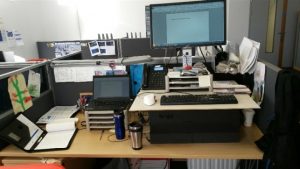 You can see my DIY version here. I am happy to report it works very well. Those are packing Styrofoam blocks under a board that my keyboard is sitting on. The height should be such that your elbows are at approximately 90 degrees w
You can see my DIY version here. I am happy to report it works very well. Those are packing Styrofoam blocks under a board that my keyboard is sitting on. The height should be such that your elbows are at approximately 90 degrees w hen using the keyboard, and the monitor top should be at your eye level. In my case I had the luxury of being able to leave space for my laptop at a lower level as well as being able to easily switch the mouse and keyboard from the higher position to the lower position providing the easy option to sit when I wanted. This turns out to be necessary. I’m now sitting only 10-20% of the time I’m in front of the computer.
hen using the keyboard, and the monitor top should be at your eye level. In my case I had the luxury of being able to leave space for my laptop at a lower level as well as being able to easily switch the mouse and keyboard from the higher position to the lower position providing the easy option to sit when I wanted. This turns out to be necessary. I’m now sitting only 10-20% of the time I’m in front of the computer.
Standing for hours has its own risks and, depending on your physical condition, can tire you out quickly, so the best option would seem to be a mix of standing and sitting. The big advantage of standing for some of the work day is that, apart from keeping your metabolism running at a higher rate, you tend to move around a lot more on your feet, which is exactly why standing is so much better for your body.
Six months into my experiment and going strong, I have noticed:
- I work a little more efficiently as when standing I seem to be more attentive to what I’m doing and more eager to finish it.
- My posture has improved (shoulder droop is slowly reversing) – this seems to happen naturally as it’s more comfortable when standing to keep your back straight.
- I will more quickly walk away to do something I need to do as opposed to mentally deciding when seated, that you can wait until you need to get up to go do that thing. Walking up to your standing desk to engage in work, instead of flopping into a comfy chair seems to keep your brain more alert and attentive.
- I don’t get any post lunch slump anymore…you know that low energy feeling when a heavy lunch is being digested. Maybe it’s because standing and associated movements trigger metabolic processes that might otherwise stall while you are sitting and digesting your lunch
I should point out though that I did have some minor back pain during the first two weeks of doing this. It may just have been due to not adjusting my heights (keyboard, monitor) just right initially and then tweaking these over time. Or is may have been as simple as my back, curved over years by seated computing (see the image at the start of the article), was realigning and strengthening in areas it needed to use to keep me standing. Anyway, it passed, and now I have no hint of any back pain. But if you try this, be aware that you may experience this and may need to push through it, or it may be your body telling you that standing for lengths of time isn’t for you.
I do highly recommend giving this a try as I can honestly say I feel the benefits every day now, and I know it’s better for me. In a few years we may wonder at how we allowed this sedentary workplace practice to go unchecked for so long.
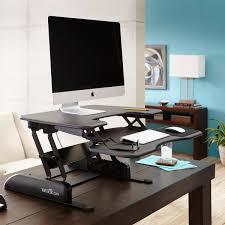
Also note that you can purchase cheaper standing alternatives like this one (Varidesk pro plus 30) to get you going, or as we prefer here at WeMakeDo…making your own from odds and ends is a very easy task and potentially life extending!

by wemakedo | Sep 10, 2016 | Uncategorized |
Here is how things were looking by Wednesday: 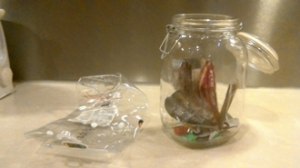 The jar was filling up but plenty of room left for the rest of the week. In the picture there is a large plastic wrapper from a set of school tights for our eldest girl. It was a spur of the moment purchase, one of those situations when we thought that avoiding plastic had to come second to getting the tights bought. I hadn’t bought tights in about 3 years, always waiting for hand me downs. I should have just sent her to school in socks for another week until I could have sourced some. There’s a plastic cat food pouch from a pack purchased ages ago (before we cared) – this will be avoided in the future by using canned meat and boxed nuts. Some fancy cheese we got as a gift had an inedible rind (we tried!!) so in that went too. All in all, we figured things were going fine.
The jar was filling up but plenty of room left for the rest of the week. In the picture there is a large plastic wrapper from a set of school tights for our eldest girl. It was a spur of the moment purchase, one of those situations when we thought that avoiding plastic had to come second to getting the tights bought. I hadn’t bought tights in about 3 years, always waiting for hand me downs. I should have just sent her to school in socks for another week until I could have sourced some. There’s a plastic cat food pouch from a pack purchased ages ago (before we cared) – this will be avoided in the future by using canned meat and boxed nuts. Some fancy cheese we got as a gift had an inedible rind (we tried!!) so in that went too. All in all, we figured things were going fine.
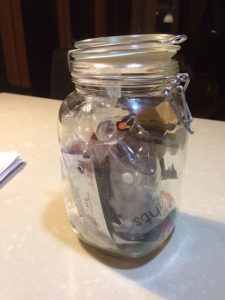 By the end of the week, we were delighted to see that we still hadn’t filled the glass jar. We found that we were taking a bit more liberty in what went into the composter (veg fried in oil??) and the hens were getting force fed potato skins and leftover toast that had a bit of jam on. The cat was given an extra day to finish the salmon skins. And mommy-eat-anything, the human garbage dump, ate any other scraps that would normally go in the bin.
By the end of the week, we were delighted to see that we still hadn’t filled the glass jar. We found that we were taking a bit more liberty in what went into the composter (veg fried in oil??) and the hens were getting force fed potato skins and leftover toast that had a bit of jam on. The cat was given an extra day to finish the salmon skins. And mommy-eat-anything, the human garbage dump, ate any other scraps that would normally go in the bin.
Here’s the overview of our junk for the week, and how we hope to eliminate each of the items:
Crisp bag from Joe’s Farm Crisps: The package is made from repurposed coffee bean bags, which is how I justified this yummy purchase. It is still my rubbish though. Not sure what to do with it. Maybe this will be an every other week indulgence..
Cat Food bag and School Tights bag: See above. Tin cans for the cat from now on, along with Whiskas cardboard boxed cat nuts. And the new tights… what was I thinking! This was a good reminder that something might not be as essential to puchase on the spur of the moment as it seems.
Cheese Rind & Wax: We eat lots of cheese… I found some recipes using cheese rinds to make stock. The wax might be compostable. We should be able to find a use or a waste free disposal option for these.
Dishwasher tab wrappers: These were bought in bulk with a Groupon voucher before we were concerned about the packaging. We’ll use them up then source non-packaged dishwasher soap (like the old cardboard boxes of Cascade that we used to use in Alaska..)
Tea Bag Covers: We won’t be buying tea bags with wrappers on them anymore. In fact, we’ll aim to switch to loose tea from a shop in Cork.
Yogurt Pot Covers: Mr MakeDo loves his lemon custard yogurt. I started making homemade yogurt in July, and just this week figured out that adding lemon curd to homemade yogurt nearly replaces his favourite yogurt. So, these will be eliminated. We recycled the paper pots (hmmm, better check that’s allowed…)
Cream Cheese Cover: I made courgette cake, which had to have cream cheese icing on it. Indulgence. We do use the cream cheese pots for lunches, but we don’t need that many. Maybe I’ll look for a homemade recipe for cream cheese. For now, though, we’ll reduce the cream cheese purchases.
TetraPak pull tabs: We need to come up with a plan to reduce Tetrapak use. We’ll post here when we do!
Expired Hairbands and Rubber Bands: No idea what to do with these yet. Suggestions welcome!
Gum Wrappers: Gum is gross – our 5 year old needs to find something else to be obsessed with. It hopefully won’t appear again.
Fruit Sticky Labels: Shopping at the Farmer’s Markets will eliminate the fruit labels, while the fruit is in season. Not a huge amount of waste, but it all counts.
Salmon Skins (not pictured here): The cat ate most of them, but we’re going to see if we can bury them or chop them up finely and compost them. I’ll ask the fishmonger what he does with the skins. Or I might ask him to skin them for me.
We also found that we should get better about cutting off inedible parts of veg before cooking them, since cooked stuff isn’t desirable in the composter. For example, pull the kale leaves off the stalks before making kale chips.
Of course a week is short enough that plenty of purchases in packaging that last longer wouldn’t reach end of life, and so won’t appear in this test. One example of this is that the family got head lice this week (!!!) and my first thought was how much room the delousing shampoo bottle would take up in our glass jar! But luckily, we bought a 6 treatment bottle, and only needed to shampoo 4 of us. So the bottle didn’t need to be discarded, yet.
Our glass jar will remain on our kitchen countertop, and the rest of the household bins will stay stacked and put away. I suppose we should warn guests.
An interesting side-effect of this high degree of attention to our household waste is that we are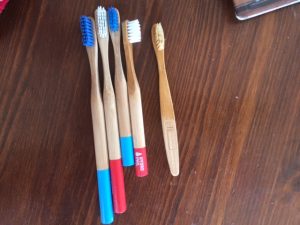 becoming even more keenly aware of the clutter in our home that we don’t need to have around. And so Zero Waste Week seems to have triggered a de-clutter month also. Some time is being spent rounding up things that we don’t love or enjoy using so much as we come across them. We hope that as this stuff leaves, that it wont get replaced by other similar stuff now that we have become more sensitive to the effects of consuming. Many of these items were things we picked up in our premarried lives that we are just no longer attached to. Some were posted for sale online and the rest will be offered to our local charity shop. We did order a set of bamboo toothbrushes (Eccoe-Verde), which we love!
becoming even more keenly aware of the clutter in our home that we don’t need to have around. And so Zero Waste Week seems to have triggered a de-clutter month also. Some time is being spent rounding up things that we don’t love or enjoy using so much as we come across them. We hope that as this stuff leaves, that it wont get replaced by other similar stuff now that we have become more sensitive to the effects of consuming. Many of these items were things we picked up in our premarried lives that we are just no longer attached to. Some were posted for sale online and the rest will be offered to our local charity shop. We did order a set of bamboo toothbrushes (Eccoe-Verde), which we love!
One other thing I’d like to mention is the use of reusable feminine products. Once you start using these, you’ll wonder why you never did before. They save a huge amount of money, and the cups are safer for you too by eliminating the risk of Toxic Shock Syndrome (TSS). Have a look at this gorgeous young lady, Lauren Singer, who’s a huge advocate, or here is a list of different alternatives for cups or pads.
I’d read about the joy that others experience as a result of minimizing, and I used to think it was a little bit corny. But, I have to admit to very much starting to feel that joy, as we move closer to having only the things we love and need. I’m already noticing more free time now that we spend less time cleaning up, throwing stuff away and taking out the rubbish.
If you want more motivation to reduce waste and minimize your stuff, have a look into Lauren Singer (mentioned above) or Bea Johnson, the queen of zero waste!
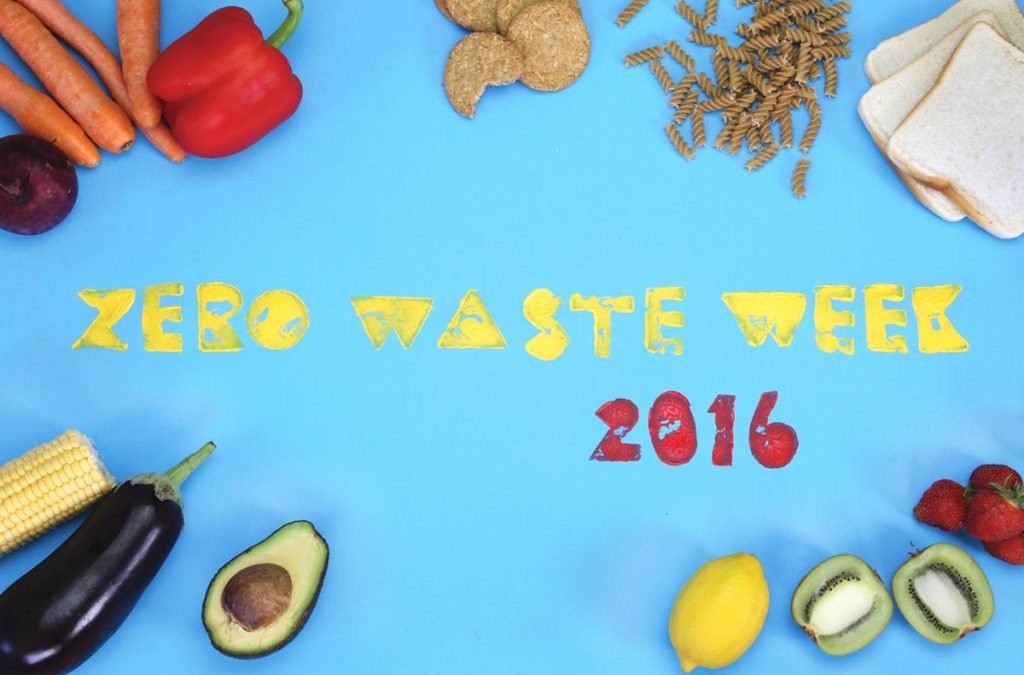
by wemakedo | Sep 5, 2016 | Uncategorized |
Having learned a lot from our experiences during plastic free July we intended to participate in the Zero waste week, starting Monday September 5th. Learning how to at least manage and control our use of single use plastics was an excellent starting point for attempting to lead the family towards trying to eliminate our household waste at least for a short period. Partaking in these organized waste efforts is a great way to coax everyone to pay attention to the problem and to play with ways to reduce. The kids are particularly interested in these experiments and love to get involved in the process.
Our plan of attack for the week will revolve around:
- Focus in particular on food waste, and reusing leftovers; for leftovers that we don’t use:
- Composting
- Expanding the diet of our trusty hens who are keen to eat almost anything we have tried on them that doesn’t go in the composter.
- Cat for any fish scraps we have (being a no meat household removes that issue for us)
- Zero plastic shopping – of course.
- These first few deal with the kitchen waste which for us is easily the biggest source of daily waste
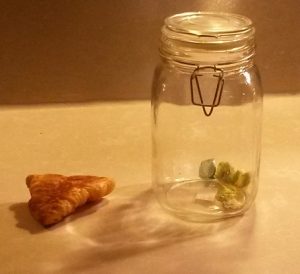 generation.
generation.
- Re-useable nappies all the way for our two kids who still need them
- No unnecessary purchasing which involves packaging of any kind.
Shown is a picture of our temporary bin which will have pride of place on our kitchen counter for the week, where everyone can see it and monitor our progress. We took the precautions of emptying and hiding all other bins in the house to start the week so we can clearly see what is being generated during the week. A leftover croissant was waiting for hen-breakfast but was later grabbed for a bedtime snack.
As with the plastic free effort, the goal here is not so much to minimise the waste but more to examine what we generate alot of and to look for alternatives. Zero waste feels like an unattainable goal but as many bloggers have demonstrated, it is a practical target to aim for and we can all make some changes to move in that direction at least.
With our family of 5, we needed to put a little more thought into preparing for areas such as nappies, school lunches and grocery shopping, but as our previous experience showed us, plastic was the issue for groceries and we found that our plastic free habits have stayed with us and it has become second nature now to just avoid plastic packaged foods. This has meant we now only shop at farmers markets and SuperValu, as well as the English Market in Cork.
Composting is also something that we have done for many years now and if you have the space in your garden it is an excellent way of reusing raw food scraps. We made our two bin composter from old pallets and a metal base from a kids cot, covered in roofing rubber membrane (leftover). We then lined it with plastic construction film (left over from our house build) to slow the breakdown of the wood. We fill one bin while the other full side breaks down, and have found that we can get good quality compost out from the full side in the time it takes us to fill the other bin. In August we emptied the latest batch of compost onto our veggie garden to help restore it.
So if you have the interest, join us for Zero waste week and learn more about what your household generates.
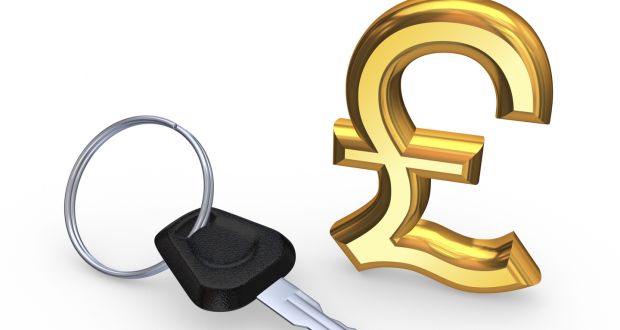
by wemakedo | Aug 21, 2016 | transport, Uncategorized |
Image courtesy of The Irish Times.
With the Euro / Sterling exchange rate recently becoming much more attractive for car buyers considering a UK import, we thought we’d describe our recent experience with this process for buying a car.
Our new arrival in November which brought the brood to three meant that we had to rethink our car situation. Neither of us care too much about the appearance or brand of car we drive but let’s face it, in rural Ireland one tends to spend a lot of time driving. So having a car that matches your needs makes moving the family around easier and maybe somewhat pleasant. Our VW Passat estate just wasn’t up to the job of managing three kids car seats easily. Having spent the winter in Alaska where our in-laws use MPVs, the obvious flexibility of these vehicles was compelling and as one gets older and busier with kids, one tends to look more at the practicality of things than the cosmetic appeal. We came home with the plan to upgrade (or downgrade depending on your view).
Figuring we’d save some cash, we opted to try to sell our own car first. So we cleaned it up, took some pretty pictures and posted our 2011 VW Passat estate online and watched the “views” roll in. Lots and lots of tyre kickers it seemed.
But no calls.
We dropped the price to try to spur the interest (14,500, down to 14,000).
Finally we had an interested person, the only interested person as it turned out, who came and viewed and bought. It only took about 6 weeks and we got 13,500 in the end. A decent price considering the advantage it gave us in making our next purchase.
For various reasons we had settled on a Peugeot 5008 7-seater as our replacement. Having bought a UK import before through a local dealer we decided to try this path again.
The exchange rate plays a big factor in whether this route is advantageous. At the time we started talking to a dealer about doing this, the Stlg/euro rate was at 1.27. Not a good exchange going by historic trends but surprisingly it was good enough to make a saving. The average UK car tends to be higher spec than the Irish equivalent and so the expectation is that you will get something at least nicer if not cheaper assuming the same year and mileage. For some it makes sense to travel to the UK, make the purchase and drive the car back to Ireland, sorting out the VRT payment along the way. We weren’t prepared to travel and so we opted for one of many dealers now who will offer this service for their own fees.
The appearance of online auction sites where buyers can get full bidding access has made this process much simpler than it used to be – both for dealers and private buyers it should be noted. In the two times we have been through this process, no one connected to the dealer was physically inspecting the car to ensure that it was good purchase. Instead the more reputable auction sites use a pre-check process that rates the cars according to their mechanical and cosmetic condition. Grade 1 is as new, and grade 3 is decent while a grade 5 might have warning lights showing or some serious bodywork issues. Apparently the dealers trust this assessment and rating enough to bid remotely on the car on your behalf. In other words they are not doing anything that you can’t do yourself except taking the logistical hassle out of the process. Also note that there is a fee for buying at these auctions which is related to how frequently you do it, and so a dealer will benefit here over the once-off buyer who pays more –for example 9.5% of the purchase price for a £10,000 value car was quoted on one site, which is significant.
One thing to beware of at this point: For a dealer who buys a car this way and then offers it to you with warranty cover, they are providing additional value on top of the car. Knowing that the car that was bought unseen will have a warranty with your local dealer certainly reduces the risk and brings some peace of mind. One dealer I bought from before did this but in this most recent case, the dealer has outsourced this to “Mapfre”, so for a discounted price I could buy a warranty from them for a year to cover the car. Apparently when you buy an extended warranty on a new car in Ireland It may be covered by this Spanish company based in ireland, so they are well established in this market.
The point for me though was that if I did buy this UK auction car myself and avoided having to pay a dealer to do it for me, then a concern was that I would not have a warranty, until I realized that I could buy one if I wanted. This makes the idea of doing this whole process myself quite feasible and with low risk.
Would I bother?
Certainly after going through this process and seeing how it works, and feeling that the dealer did little for his cut other than get the car shipped over to me and put through the VRT payment process, I would strongly consider it.
You get to pick your car, and importantly you get to bid yourself so you know exactly what you are willing to spend as the bidding is driving the price up during the auction. This avoids the difficulty of having to provide a bid limit to the dealer in advance without knowing if it will be enough for a successful outcome, only to find out later that you lost your ideal car to another bidder for the sake of another hundred quid.
Some useful links:
To transfer money from euros to sterling – I recommend avoiding banks and going with Transferwise a most excellent facility that charges the least for exchange transfers.
Of course we bought before “Brexit” happened, and so now the post- Brexit exchange rate being in your favour, makes this a most attractive option for those willing to put in the additional effort.

